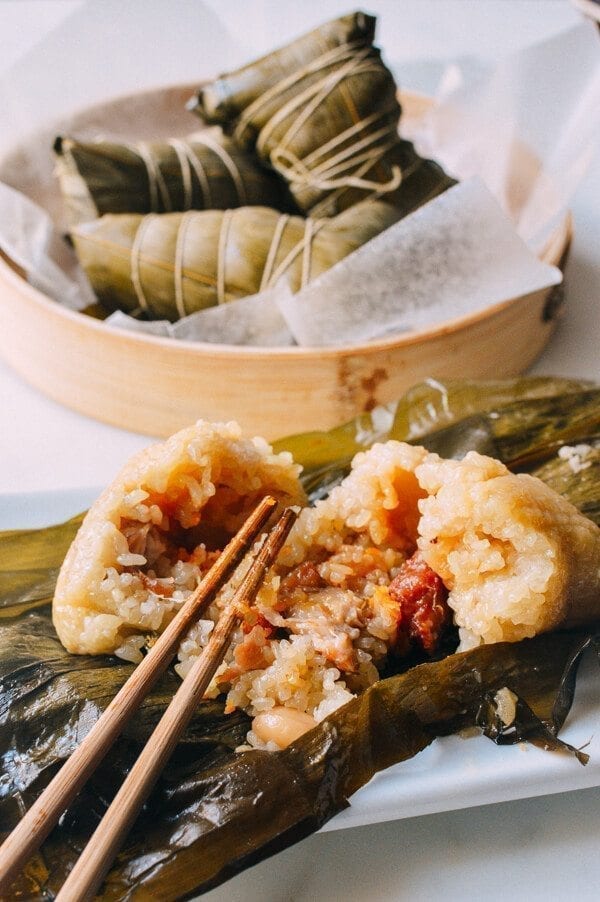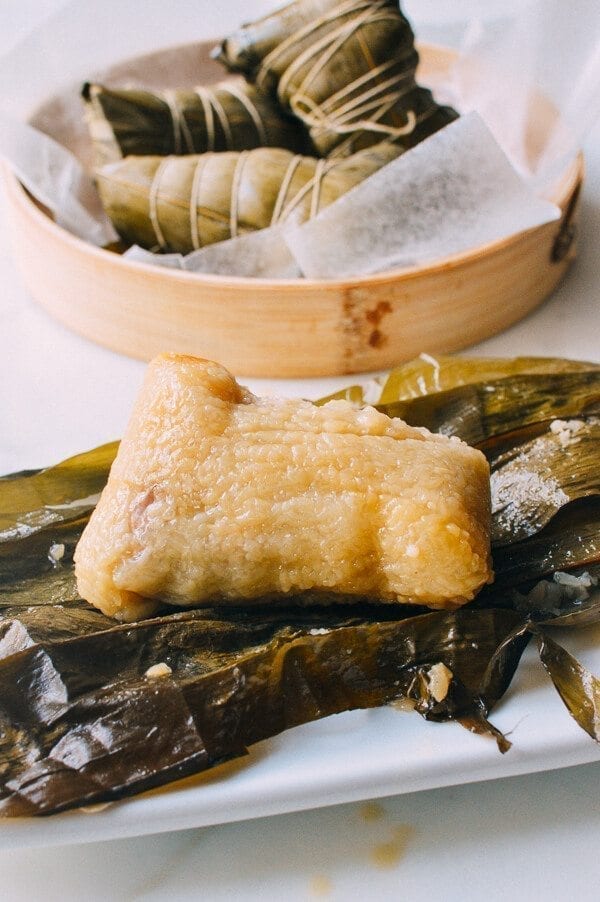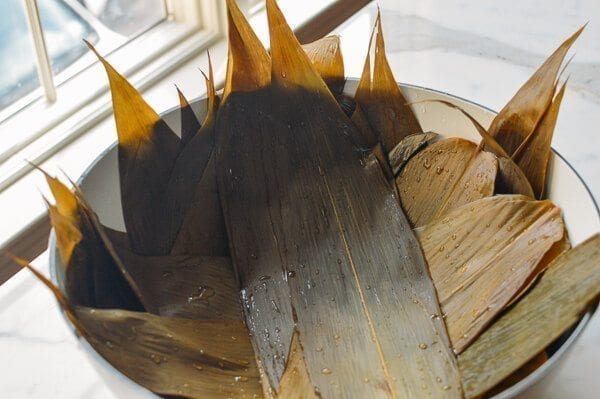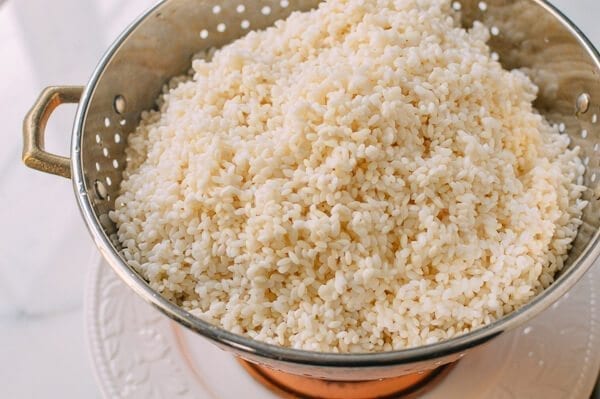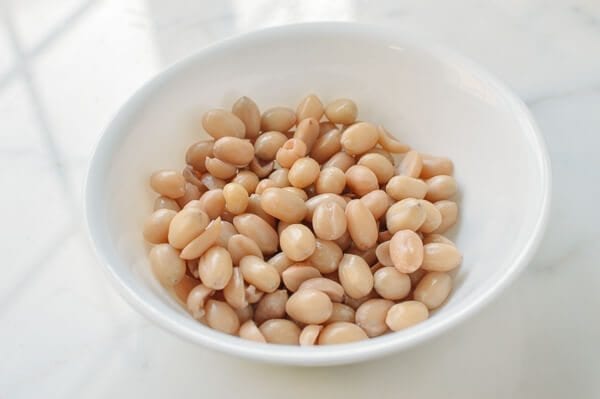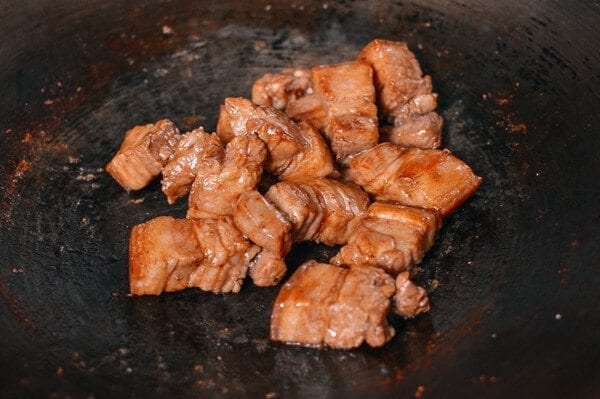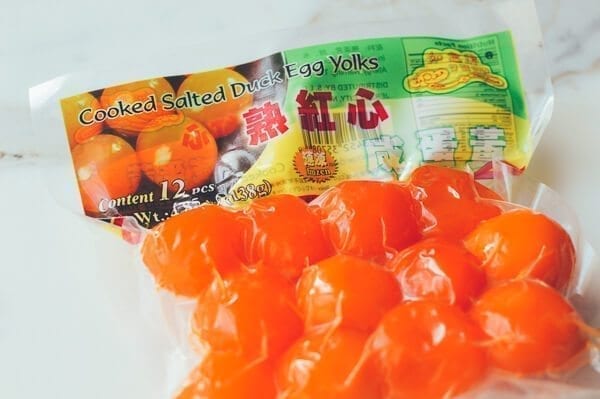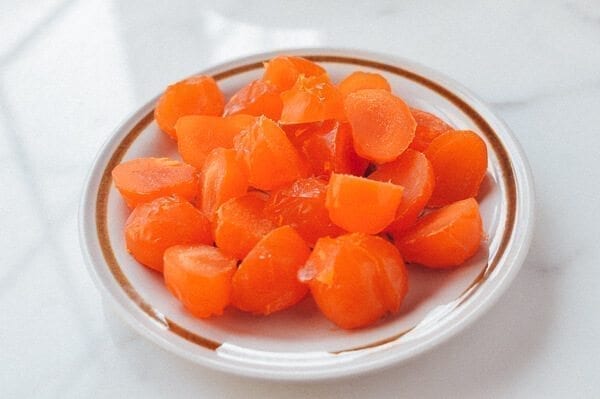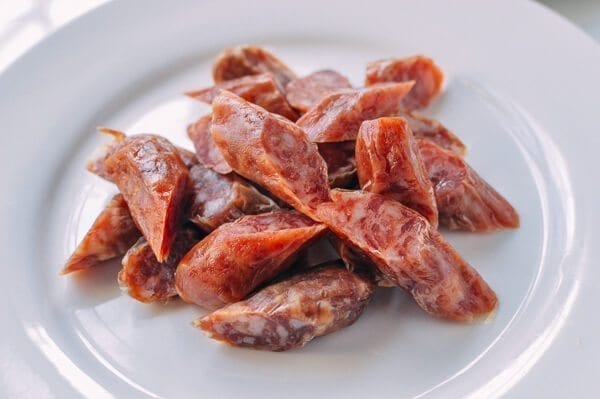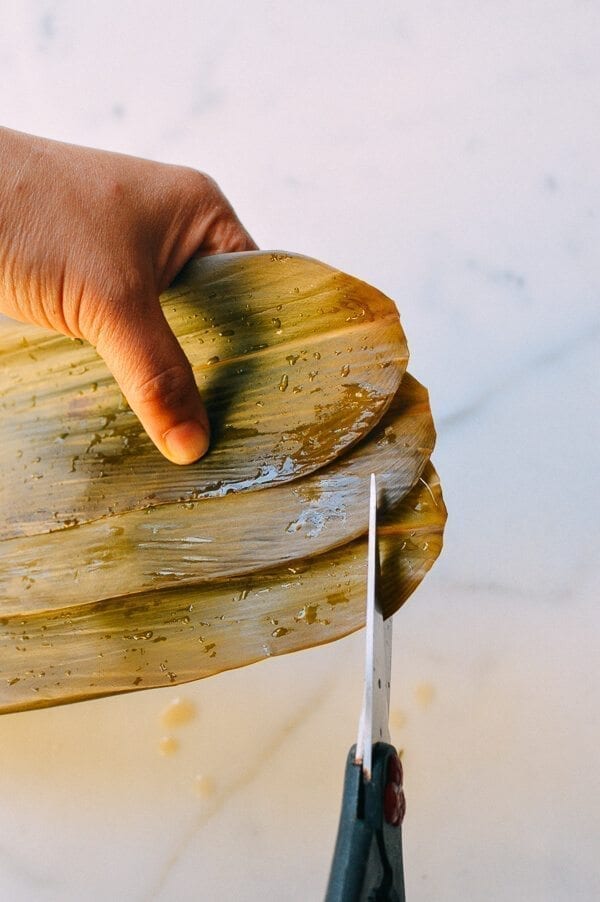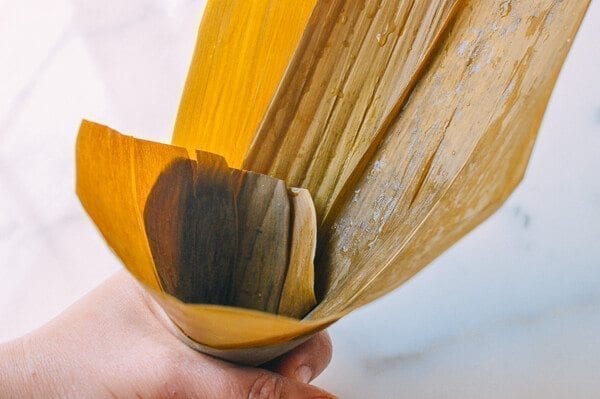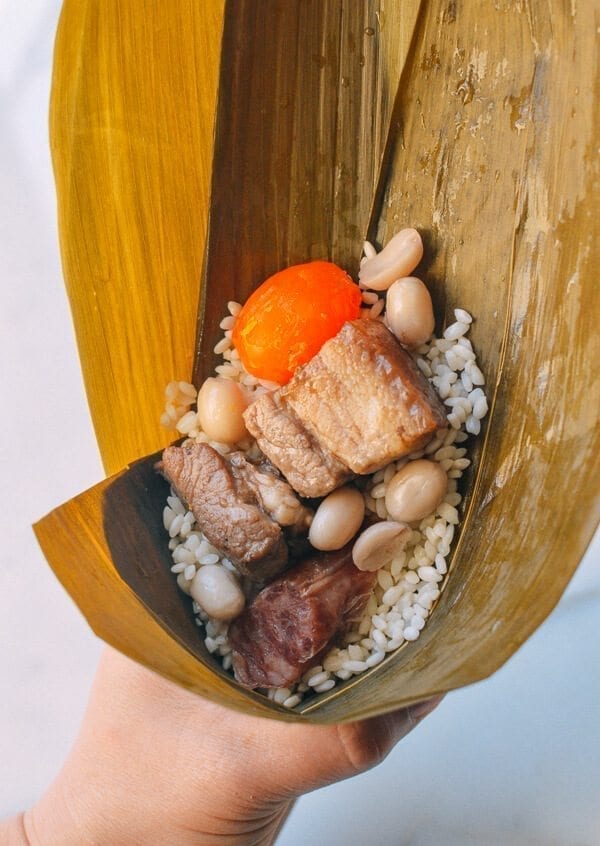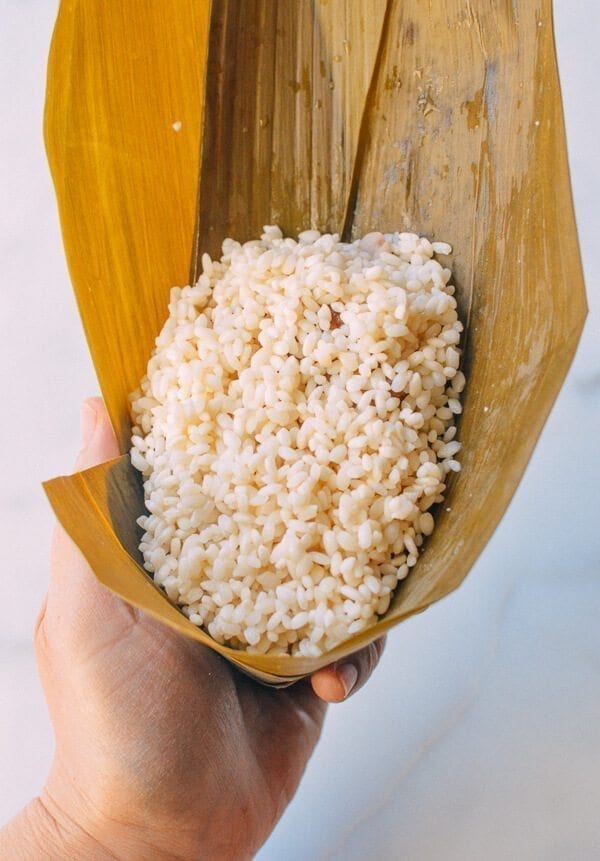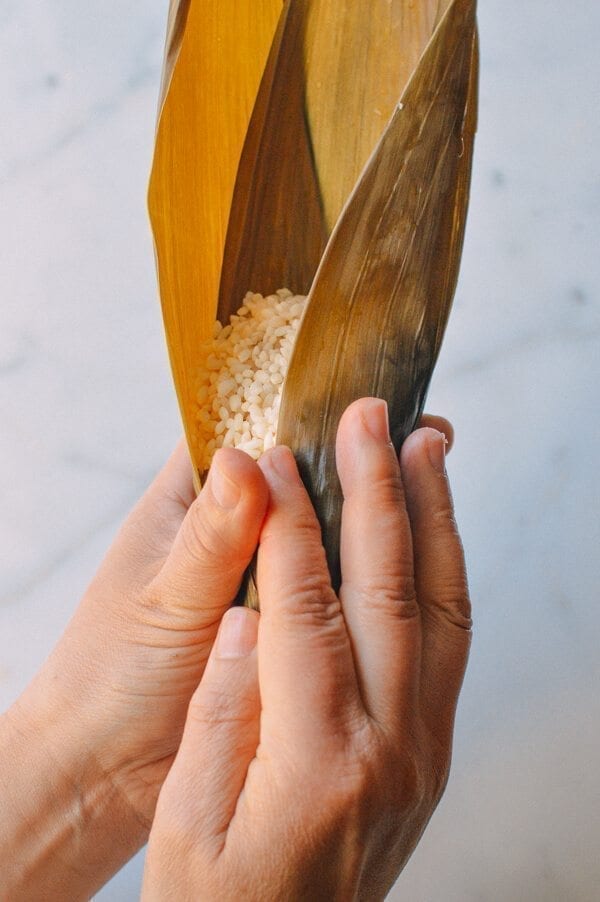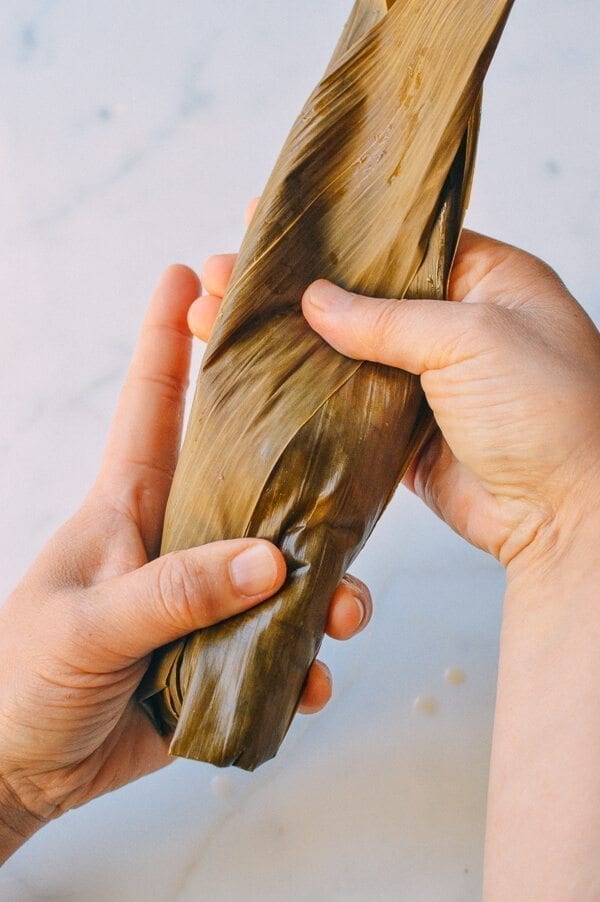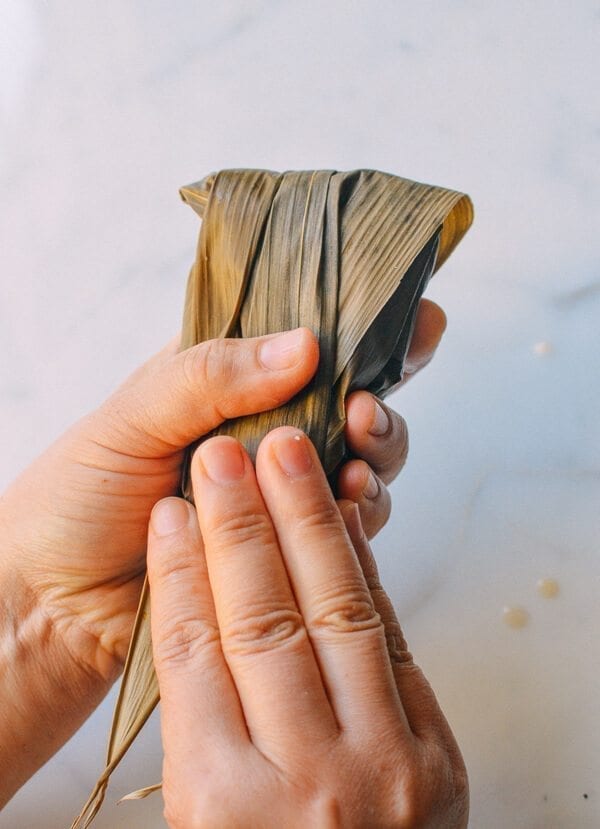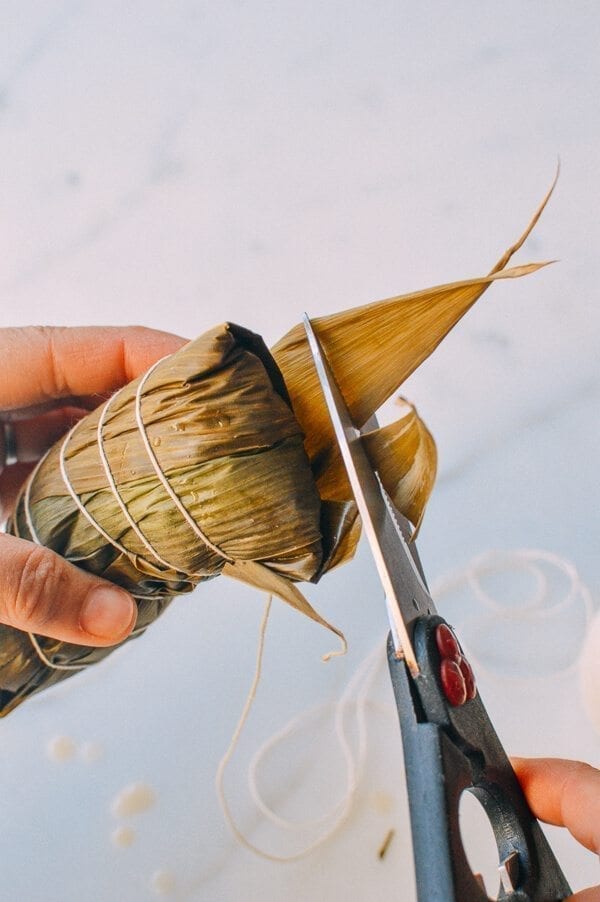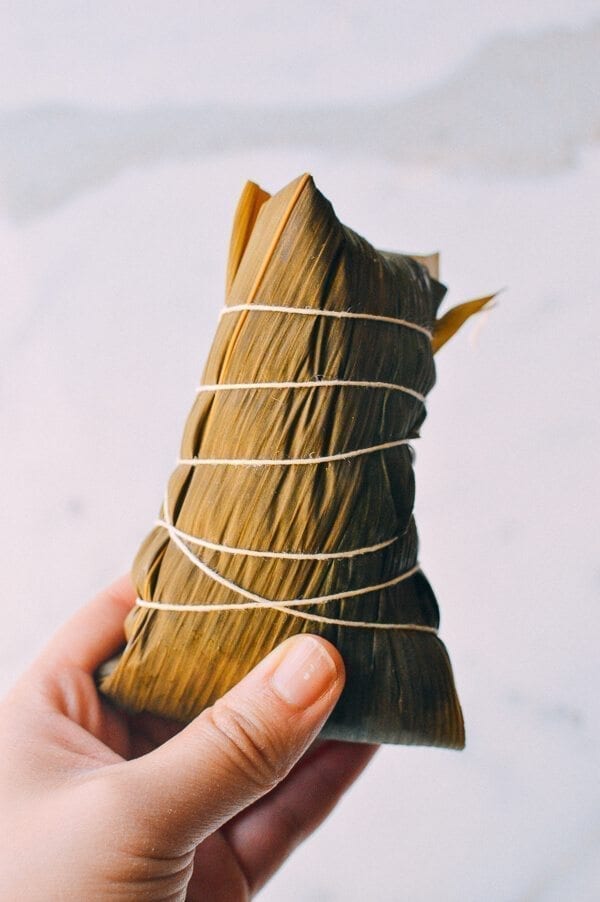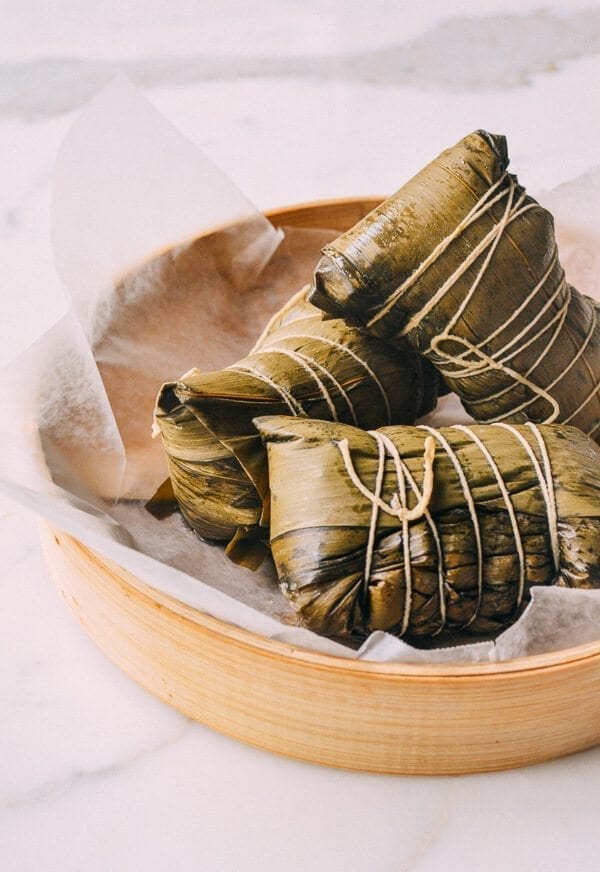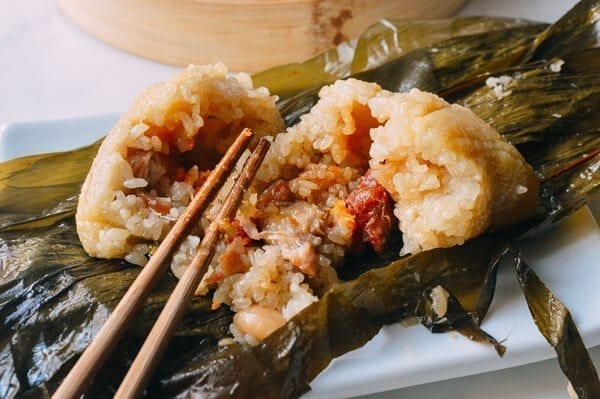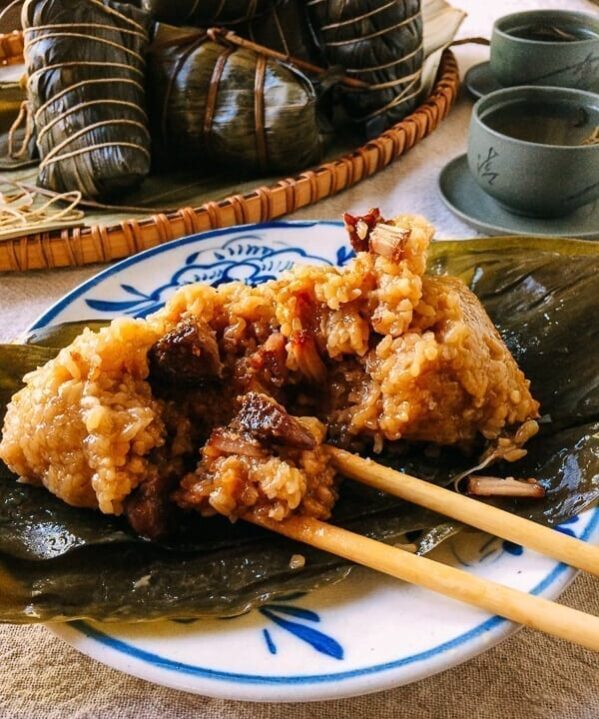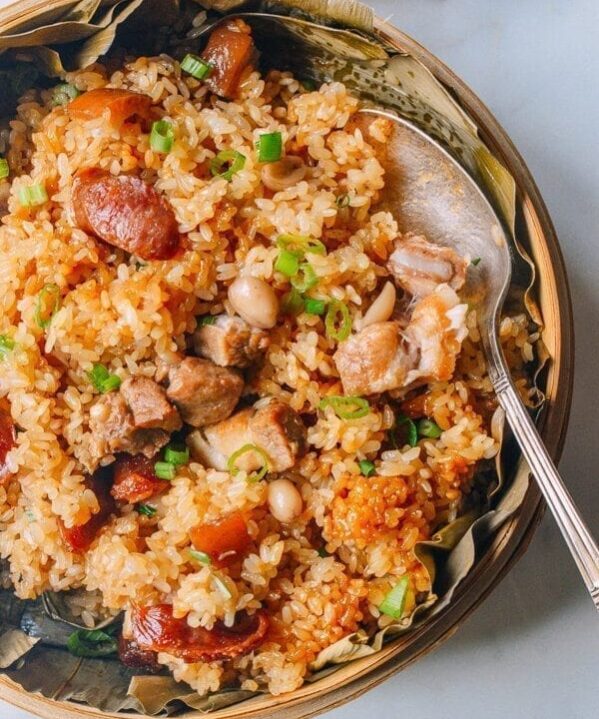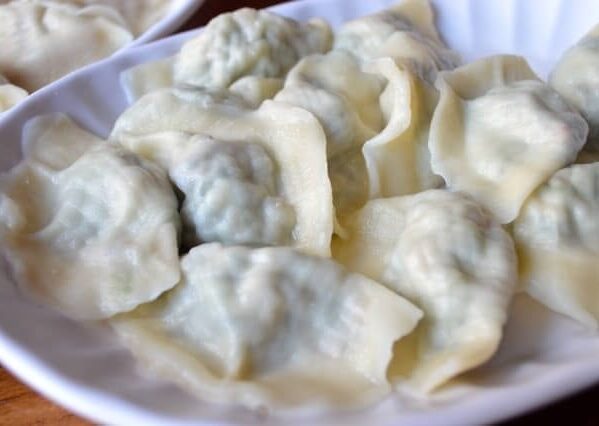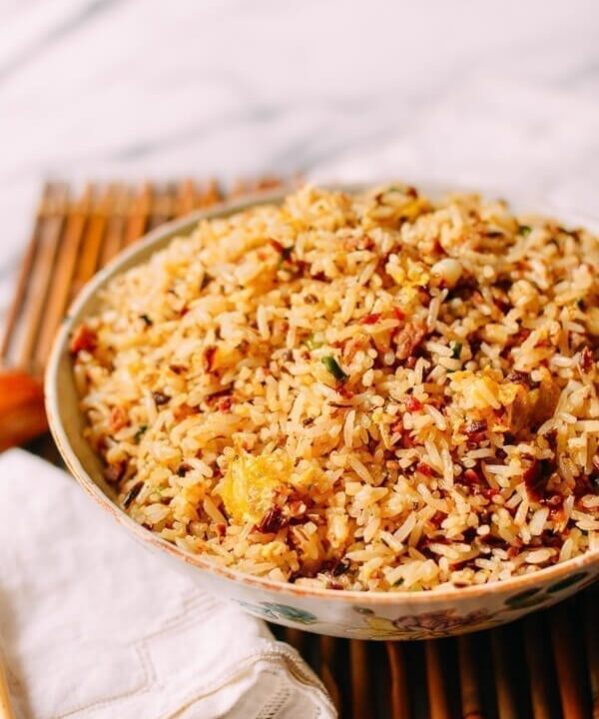Just in case this is the first time you’re reading about zongzi (粽子), or joong in Cantonese, it’s basically a Chinese version of a tamale: rice wrapped inside a leaf, then boiled in water until cooked through.
They can be savory or sweet, and everyone has their favorite flavors. Bill pretty much only likes the zongzi recipe we’re posting here today—with salty duck egg yolks and the tender, fall-apart pork belly, which is what his mother used to make.
My personal favorite is my aunt’s lye water zongzi (碱水粽). Despite the weird name, it’s a very basic zongzi with a distinctive yellow color and subtle flavor. Until we developed the recipe for it, I hadn’t had it for over thirty years, since I left Shanghai as a teenager. The moral of the story is—don’t judge a zongzi by its name! In fact, you might apply that truism to most Chinese dishes…
Other Asian countries also have their own variation of this special treat. When I was little, I don’t remember anyone buying zongzi (粽子), because every family made their own. It was actually a very special event. My grandma and my aunt used to make at least two to three varieties each time, and it was a huge production!
It was a daylong affair with preparations started the night before. In fact, if you’ve ever had the pleasure of having someone make these for you, you should be very appreciative—it’s a lot of work and very few people know how to make these well.
Zongzi: A Dragon Boat Festival Tradition
Wikipedia has a great write-up about the tradition of making zongzi, and since it’s so elegantly written already…
“Zongzi are traditionally eaten during the Duanwu Festival (Mandarin: Duānwǔ), which falls on the fifth day of the fifth month of the lunar calendar (approximately late-May to mid-June).
A popular belief amongst the Chinese of eating zongzi involved commemorating the death of Qu Yuan, a famous Chinese poet…Known for his patriotism, Qu Yuan tried unsuccessfully to warn his king and countrymen against the expansionism of their Qin neighbors.
When the Qin general Bai Qi took Yingdu, the Chu capital, in 278 BC, Qu Yuan’s grief was so intense that he drowned himself in the Miluo river. According to legend, packets of rice were thrown into the river to prevent the fish from eating the poet’s body.”
The story is grim, yes, but that’s how it goes! Zongzi used to be only a once-per-year, homemade treat for the Duanwu Festival (Just in case you are wondering, this year’s Duanwu Festival is on June 25), but now they are available in Chinese grocery stores year-round with many variations. I never buy them, mainly because I never know how long they’ve been sitting on the shelves.
As the mother of a Chinese family, I felt a sense of duty to master this zongzi recipe to carry on the tradition and pass it down. If you find yourself in my shoes, you must give this zongzi recipe a try this year, and if not, then next year. You will make your mother/grandmother proud. If you’ve never had zongzi before, and want to try them, you’ll make US proud!
Preparing Zongzi
Making zongzi is a fairly labor-intensive process––it takes two days. We’ve outlined the preparation of each component below, followed by directions for putting the zongzi together, and finally, directions for cooking.
Some people can wrap these babies with speed and ease, but for others, it can devolve into mission impossible-level fumbling (let’s just say that Bill had some difficulties).
But don’t worry. With a little practice, and our step-by-step instructions, you’ll be folding them properly in no time. And as far as size and shape are concerned, let’s say there is no right or wrong. As long as it’s wrapped tight and does not open up during cooking, it’s a success!
If you want more tips on the different types of Zongzi and some cool pictures and videos, see our post, China’s Dragon Boat Festival & Rice Dumplings Galore!
Also, don’t miss our post on Jianshui Zong Alkaline Rice Dumplings if you are looking for the sweet version. We also have a Shanghai Zongzi made with light and dark soy sauce.
Finally, if you’d like instructions on how to cook these faster, check out our post on How to Cook Zongzi in an Instant Pot.
Cantonese Zongzi: Recipe Instructions
Here’s the full list of ingredients you’ll need. We’ll break it down for you to prepare each component.
- 36 to 40 dried reed leaves (2 to 3 leaves per zongzi)
- 5 cups uncooked short grain sticky rice (also called glutinous rice, or “sweet rice”)
- 2 tablespoons light soy sauce, plus 2 teaspoons
- 2 teaspoons salt, plus 1/2 teaspoon
- 2/3 cup of raw peanuts
- 1 pound pork belly, cut into 12 equal pieces
- 1/2 teaspoon sugar
- 2 teaspoons shaoxing wine
- 1/2 teaspoon ground white pepper
- 1 teaspoon oil
- ½ cup water
- 6 salted duck egg yolks
- 3 Chinese sausages (lop cheung)
To prepare the zongzi leaves:
- 36 to 40 bamboo leaves (use 2 to 3 leaves per zongzi)
First, soak the leaves overnight. The next day, wash and rinse each leaf front and back, keeping them in a large bowl or tub of water until wrapping time so they don’t dry out.
To prepare the sweet rice:
- 5 cups of short grain sweet rice
- 2 tablespoons light soy sauce
- 2 teaspoons salt
Soak the sweet rice overnight. The next day, drain completely in a colander. Mix the soaked, uncooked rice with light soy sauce and salt in a large bowl and set aside.
To prepare the peanuts:
- 2/3 cup of raw peanuts
Soak the peanuts overnight. The next day, boil for 5 minutes, drain, and set aside.
To prepare the pork belly:
- 1 pound pork belly, cut into 12 equal pieces
- 2 teaspoons light soy sauce
- 1/2 teaspoon sugar
- 2 teaspoons shaoxing wine
- 1/2 teaspoon salt
- 1/2 teaspoon ground white pepper
- 1 teaspoon oil
- 1/2 cup water
In a bowl, toss the pork belly with the light soy sauce, sugar, shaoxing wine, salt, and white pepper. Marinade overnight. The goal of this step is to make the pork belly slightly too salty, because the rice will absorb the excess salt, giving the zongzi its distinctive savory, umami flavor.
Heat the oil in a wok over medium heat. Cook the pork belly for a few minutes before adding the water. Cover the wok with the lid, and cook for 5-10 minutes until the liquid is gone. Remove from the wok and let cool.
To prepare the additional ingredients:
- 6 salted duck egg yolks
- 3 Chinese sausages (lop cheung)
Cut the egg yolks in half. Cut the sausages into 12 equal pieces. Set aside in separate bowls.
Wrapping the zongzi:
Woo! Good job. Now you are all set to wrap these little bundles of deliciousness. We’ve provided step-by-step photos for how to wrap the zongzi below.
Before you start, there are a few things to remember:
- You must use kitchen shears to cut away at least half an inch off the bottom of every leaf where the leaf stem is since can easily puncture your precious zongzi while wrapping.
- Make sure the kitchen twine won’t break easily. To do this, it’s best to wet the twine first by soaking it in a bowl of water.
- It’s best to tie one end of the twine to an anchor point or kitchen fixture (e.g. you kitchen sink), because you will only have one hand to tie the zongzi. Your other hand will be holding the zongzi. Or have someone help you out! Making zongzi is like making a big batch of dumplings or wontons—all hands on deck! Just make sure that the newbies are holding the strings and the seasoned pros are doing the folding! Hah!
- If leaves rip anywhere during the wrapping process, you’ll need to start over and discard the ripped leaf. That’s why I call for more leaves than is technically needed. Some of the leaves are bound to get ripped.
Start by layering a couple leaves together and folding up the bottom to create a cone.
Fill with a little rice on the bottom, along with your egg yolk, peanuts, pork belly, and Chinese sausage.
Top with a bit more rice.
Fold the two sides into the middle lengthwise, cupping your hands at the bottom of the cone so it doesn’t fall apart.
Pinch the leaves at the top so you get a tight seal.
Fold the Zongzi leaves down…
And tie the zongzi securely. Just get it tightly sealed. Doesn’t have to be pretty. Cut off the excess on the leaves with your trusty kitchen shears.
And that’s it! Now do it a bunch more times until your leaves and filling are used up.
To cook the zongzi:
Get a medium-sized pot and neatly nest the zongzi inside, avoiding large gaps. Put a large plate directly on top of the zongzi to weigh them down. Fill the pot with cold water, until the zongzi are submerged. Place the pot on the stove over medium high heat. Once the water boils, turn the heat to low/medium-low, and let it simmer for at least 7-8 hours.
The water should be “moving” while simmering, but there should be no large roiling bubbles. You must check the pot fairly often to make sure the zongzi are always submerged in water. Only add boiling water to adjust the water level—do not add room temperature or cold water. Keep a kettle of hot water on the stove so that you’re prepared throughout the 7-8 hour cooking time.
Once the 7-8 hours is up, eat the zongzi while they’re hot! Sweet zongzi can be enjoyed at room temperature, but savory zongzi are really the best when they’re steamy and delicious.
If you don’ thave 7-8 hours to cook these, they can also be cooked in an Instant Pot in a fraction of the time (90 minutes). Check out our post on How to Cook Zongzi in an Instant Pot for full instructions.
Some useful tips for enjoying your zongzi:
- To eat, simply cut the twine and unwrap the leaves to reveal the zongzi inside.
- Zongzis can be frozen after they cool to room temperature. To reheat, first defrost the zongzi by taking it out of the freezer a few hours prior to cooking time. Re-boil the zongzi in water for 15-20 minutes.
- Zongzi are usually served as is, but who’s gonna stop you from eating them with your favorite chili sauce? No one, that’s who!
Cantonese-Style Zongzi (Rice Dumplings)
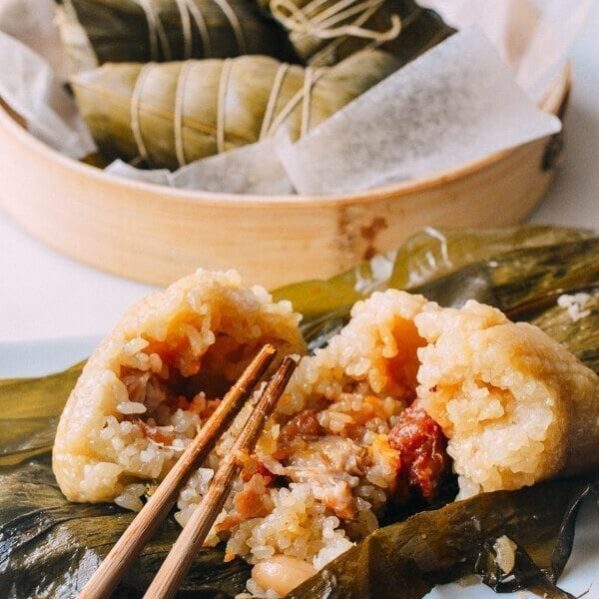
Ingredients
- 36 to 40 dried bamboo leaves (2 to 3 leaves per zongzi)
- 5 cups uncooked short grain sticky rice (also called glutinous rice, or "sweet rice")
- 2 tablespoons light soy sauce (plus 2 teaspoons)
- 2 teaspoons salt (plus 1/2 teaspoon)
- 2/3 cup raw peanuts
- 1 pound pork belly (450g, cut into 12 equal pieces)
- 1/2 teaspoon sugar
- 2 teaspoons shaoxing wine
- 1/2 teaspoon ground white pepper
- 1 teaspoon oil
- ½ cup water
- 6 salted duck egg yolks
- 3 Chinese sausages
Instructions
- First, soak the leaves overnight. The next day, wash and rinse each leaf front and back, keeping them in a large bowl or tub of water until wrapping time so they don’t dry out.
- Soak the sweet rice overnight. The next day, drain completely. Mix the soaked, uncooked rice with 2 tablespoons light soy sauce and 2 teaspoons salt in a large bowl and set aside.
- Soak the peanuts overnight. The next day, boil for 5 minutes, drain, and set aside.
- In a bowl, toss the pork belly with 2 teaspoons light soy sauce, 1/2 teaspoons sugar, 2 teaspoons shaoxing wine, 1/2 teaspoon salt, and white pepper. Marinate overnight. The goal of this step is to make the pork belly slightly too salty, because the rice will absorb the excess salt, giving the zongzi its distinctive savory, umami flavor.
- The next day, heat the oil in a wok over medium heat. Cook the pork belly for a few minutes before adding the water. Cover the wok with the lid, and cook for 5-10 minutes until the liquid is gone. Remove from the wok and let cool.
- Cut the egg yolks in half. Cut the sausages into 12 equal pieces. Set aside in separate bowls.
- Follow the step-by-step photos to wrap the zongzi. Remember: You must cut away at least half an inch off the bottom of every leaf you use. Make sure the kitchen twine won’t break easily. To do this, it’s best to wet the twine first by soaking it in a bowl of water. It’s best to tie one end of the twine to an anchor point or kitchen fixture (e.g. you kitchen sink), because you will only have one hand to tie the zongzi. Your other hand will be holding the zongzi. Or have someone help you out! If leaves rip anywhere during the wrapping process, you’ll need to start over and discard the ripped leaf. That’s why I call for more leaves than is technically needed. Some of the leaves are bound to rip.
- To cook the Zongzi, get a medium-sized pot and neatly nest the zongzi inside, avoiding large gaps. Put a large plate directly on top of the zongzi to weigh them down. Fill the pot with cold water, until the zongzi are submerged. Place the pot on the stove over medium high heat. Once the water boils, turn the heat to low/medium-low, and let it simmer for at least 7-8 hours.
- The water should be “moving” while simmering, but there should be no large roiling bubbles. You must check the pot fairly often to make sure the zongzi are always submerged in water. Only add boiling water to adjust the water level—do not add room temperature or cold water. Keep a kettle of hot water on the stove so that you’re prepared throughout the 7-8 hour cooking time.
- Once the 7-8 hours is up, eat the zongzi while they’re hot! Sweet zongzi can be enjoyed at room temperature, but savory zongzi are really the best when they’re steamy and delicious.
Tips & Notes:
nutrition facts
